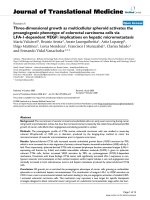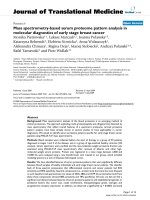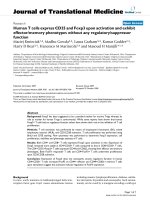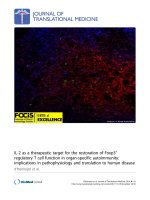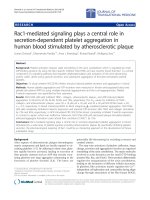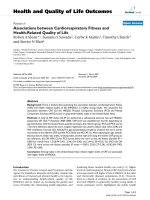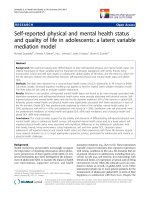báo cáo hóa học: " How do medical students value health on the EQ-5D? Evaluation of hypothetical health states compared to the general population" ppt
Bạn đang xem bản rút gọn của tài liệu. Xem và tải ngay bản đầy đủ của tài liệu tại đây (403.28 KB, 6 trang )
BioMed Central
Page 1 of 6
(page number not for citation purposes)
Health and Quality of Life
Outcomes
Open Access
Research
How do medical students value health on the EQ-5D? Evaluation of
hypothetical health states compared to the general population
Maria-Theresa Barbist
†1
, Daniela Renn
2
, Bianca Noisternig
3
,
Gerhard Rumpold
1
and Stefan Höfer*
†1
Address:
1
Clinic of Medical Psychology, Medical University Innsbruck, Schöpfstraße 23a, 6020 Innsbruck, Austria,
2
Oppolzerstr. 8, 6020
Innsbruck, Austria and
3
Öffentliches Landeskrankenhaus Natters, In der Stille 20, 6161 Natters, Austria
Email: Maria-Theresa Barbist - ; Daniela Renn - ;
Bianca Noisternig - ; Gerhard Rumpold - ; Stefan Höfer* -
* Corresponding author †Equal contributors
Abstract
Background: Medical students gain a particular perspective on health problems during their
medical education. This article describes how medical students value 10 hypothetical health states
using the EQ-5D compared to the general population.
Methods: Based on a sample of 161 medical students (male: 41%) we compared valuations of 10
hypothetical EQ-5D health states collected in face to face interviews with the valuations of the
general population. Self-reported health on the EQ-5D was also collected.
Results: Every third health state was valuated higher by the medical students compared to data of
the general population. The differences were independent of the severity of the hypothetical health
state. Concerning the self-reported health, the majority of the students (66%) reported no
problems in the five EQ-5D domains (EQ-5D VAS M = 87.3 ± 9.6 SD). However, when compared
to an age-matched sample the medical students show significantly more problems in the area of
pain/discomfort and anxiety/depression.
Conclusion: Medical students have a tendency to value health states higher than the general
public. Medical professionals should be continuously aware that their assessment of the patients
health state can differ from the valuations of the general population.
Background
The assignment of preferences to certain health states is a
critical and controversial topic. This is especially true
when it comes to valuing our own health in contrast to
valuing health of others. In any case people refer to the
salient and most important aspects of their own lives to
value health states. These valuations can be implicit or
explicit, however they always exist. Medical decisions on
an individual basis or policy basis are and always will be
influenced by these valuations [1].
In a recent European survey on the acceptance of quality
of life measurement between 72–90% of the physicians
accepted quality of life (QoL) as an outcome measure,
however with less than 50% accepting the concept of
quality adjusted life years (including utility measure-
Published: 11 December 2008
Health and Quality of Life Outcomes 2008, 6:111 doi:10.1186/1477-7525-6-111
Received: 16 June 2008
Accepted: 11 December 2008
This article is available from: />© 2008 Barbist et al; licensee BioMed Central Ltd.
This is an Open Access article distributed under the terms of the Creative Commons Attribution License ( />),
which permits unrestricted use, distribution, and reproduction in any medium, provided the original work is properly cited.
Health and Quality of Life Outcomes 2008, 6:111 />Page 2 of 6
(page number not for citation purposes)
ment) [2]. In a similar survey in the United States and
Canada only about one third of the physicians had ever
collected data on quality of life or had taken it systemati-
cally into account in clinical decision making [3]. There-
fore it is of importance within the medical curriculum to
sensitize students to the impact of QoL and health state
valuations on the decision making process by involving
them in health valuation tasks. Medical students gain a
different perspective on health problems during their
medical education by developing the role of a medical
doctor. The participation in a health state valuation task
potentially allows them to reflect on a patients' perspec-
tive on decision making when being confronted with
hypothetical health states. Further it has been acknowl-
edged that there is a need for health related quality of life
education in medical school [4].
Methods for generating health preferences are based on
the development of decision theory. Using health prefer-
ences, quality-adjusted life-years (QALYs) can be calcu-
lated. Conceptually QALYs summarize the treatment
outcome in terms of time spent in a particular health state
and with a particular quality of life [5]. Different tools
were developed to measure health states or health-related
quality of life (HRQL), which allow the calculation of
QALYs, e.g. Short Form-6D [6], Health Utility Index I-III
[7] and EQ-5D [8].
The EQ-5D is a well established health-utility index meas-
ure and was originally designed to complement other
forms of quality of life measures. It has been purposefully
developed to generate a cardinal index of health, therefore
it has considerable potential for use in economic valua-
tion [9]. It is widely used for monitoring the health status
of patient groups at different points in time: (1) for valu-
ation and audit of health care, by measuring changes in
health status in individual patients and in groups of
patients; (2) further for assessing the seriousness of condi-
tions, providing relevant information for resource alloca-
tion at a variety of levels; (3) assisting in providing
evidence about medical effectiveness in processes where
drugs or procedures have to be approved; (4) monitoring
and establishing population health status locally, nation-
ally and internationally [8]. The standard approach of the
EuroQol group to establish health preferences is the Vis-
ual Analogue Scale rating [9].
The purpose of this study was to describe how medical
students value 10 hypothetical health states using the EQ-
5D in comparison to the general population.
Methods
In face to face interviews with 180 students of the Medical
University Innsbruck, conducted in 2001 and 2002, we
collected data on self-reported health and valuations of
EQ-5D hypothetical health states. The participation in
this study was part of their educational programme during
one term in their second year of medical school, that
included a basic lecture on quality of life. Participation
was voluntary and anonymous. Ethical approval was
obtained from the institutional review board.
We used the German version of the EQ-5D for which data
of the general population of Germany were available.
The EQ-5D consists of 5 dimensions (mobility, self-care,
usual activity, pain/discomfort, anxiety/depression). For
each dimension there are three answer categories: no
problem (1), some problems (2), or severe problems (3).
The combination of five dimensions with three answer
categories [3
5
] result in 243 possible health states
described as vectors (e.g. 11231, no problems walking
around, no problems with self care, some problems with
performing usual activities, extreme pain or discomfort
and not anxious or depressed). The second component of
the EQ-5D is a visual analogue scale (VAS), providing the
respondents with the option to describe their current
overall health status on a thermometer-type scale ranging
from 0 – 100 [8].
A trained interviewer guided the participants in groups of
10 people through the valuation process. First, students
rated their own health status by completing both parts of
the EQ-5D questionnaire. Second, ten of the possible 243
health states were presented for the valuation task.
We chose 10 hypothetical health states out of a previously
used set of health states used for modelling the full set of
EQ-5D health states [10]. The set included 2 health states
of the category "very mild" (11112, 21111), 2 "mild"
health states (11113, 12121), 3 "moderate" health states
(12222, 21232, 21323) and 3 "severe" health states
(22323, 32223, 32232).
The interviewers asked the respondents to rank the 10
hypothetical health states from best to worst according to
their individual perception. In a next step the students
marked each health state on a thermometer-style VAS
according to its relative rank. The VAS was bounded by the
worst imaginable health state (0) and the best imaginable
health state (100). Participants were encouraged to use a
form of "bisectioning," where they begin by marking the
best and worst states on the rating scale followed by the
intermediate states.
Since there is no EQ-5D data available for the general
population of Austria, we compared our data on self-
reported health of medical students with the self-reported
health data of a German general population sample [11].
The German sample was randomly selected to create
Health and Quality of Life Outcomes 2008, 6:111 />Page 3 of 6
(page number not for citation purposes)
norm values for the general population. 2022 subjects
between 19 and 93 years of age were tested with the EQ-
5D. For the comparison with our data we used the self-
reported health of the age group 20–30 years (N = 292,
female: 48.3%, mean age: 24.81 ± 3.15 SD, high educa-
tion (degree or professional qualification): 30.9%; per-
sonal communication with Dr. Hinz 17.04.08).
For the comparison of the valuation of hypothetical
health states we used the data from the German EQ-5D
valuation study by Claes et al. [12], collected in a different
random sample of the German population (N = 339,
female: 44.8%, ≤ 34 years: 23.0%, high education: 33.0%)
[13]. Respondents were asked to value up to 15 different
health states from a sample of 43 states. The participants
were given selected cards with the description of the
health states. These cards had to be ranked on the VAS
scale. TTO rating of states was also undertaken. For our
comparison we used the collected VAS data.
We used descriptive statistics to describe the sample and
health states. Chi-square (χ
2
) statistics were used to test
for group differences for nominal data.
Results
Sample characteristics
Complete data was available for 161 participants (89.4%
participation rate). The mean age of the students was 24.3
(± 4.9 SD) with no significant gender differences (M ± SD
male: 24.83 ± 4.86, female: 24.01 ± 4.93; t-Test: p > .05).
The majority of the students were female (59.0%). Own
illness experience was reported by 25.9% of the sample,
75.3% experienced illness in their close family. As the stu-
dents have only been in their second year of medical train-
ing including no practical training, no more than 49%
reported experience of illness in others than close family.
No experience with own illness or illness of others
reported 13.7% of the sample. About one quarter of the
participants were smokers (Table 1).
The students reported a mean EQ-5D VAS score of 87.3 (±
9.6) with no significant differences between male and
female students (male: 87.1 ± 7.8; female: 87.9 ± 10.0, t-
Test: p > .05). Compared to a sample of the general popu-
lation aged 20–30 (M
VAS
= 87.5 ± 14.8 [11]) there were no
significant differences (t-Test: p > .05). Male students
tended to report lower VAS scores compared to the male
general population aged 20–30 (student: 87.1 ± 7.8;
Table 1: Socio-demographics and illness experience (N = 161)
medical students (N = 161)
Characteristic
gender (%)
1
male 39.8
female 59.0
missing 1.2
Age
(mean (SD)) 24.34 (4.9)
(Median) 22.5
(min-max) 20–49
Illness Experience (%) Yourself 25.9
Family 75.3
Others 49.1
none 13.7
Smoker (%) Never 58.4
Non-/former smoker 17.4
Smoker 24.2
Working status (%) Employed-self/employed 6.4
Housework 0.6
Student 91.9
Other 1.3
Years of education (%) ≤ 9 years 0.0
10–13 years 82.6
≥ 14 years 17.4
1
missing data N = 2
Health and Quality of Life Outcomes 2008, 6:111 />Page 4 of 6
(page number not for citation purposes)
general
20–30
: 89.2 ± 13.4, t-Test: p < .10; Table 2). There
were no significant differences for females.
The students described 10 different EQ-5D health states
which, with one exception, were all very mild or mild
health states (Table 3). Two-thirds of the participants
reported no problems in the 5 areas of the EQ-5D (11111:
65.8%) with a mean VAS score of 89.6 (± 7.0). The health
state 11112 (moderately anxious or depressed) was
reported by 13.7% of the students, with a mean VAS score
of 85.5 (± 9.3). The health state 11121, indicating moder-
ate pain or discomfort, was reported by 9.9% of the stu-
dents (VAS 82.9 ± 11.1; see other health states in Table 3).
The biggest proportion of participants reporting problems
in any of the five dimensions was within anxiety/depres-
sion (22.5%), with no gender differences (chi
2
-Test: p >
.05). No student reported any problems with self-care.
Compared to the general population aged 20–30 [11] the
students reported significantly more problems in the EQ-
5D areas pain/discomfort and anxiety/depression (chi
2
-
Test: p < .01; Table 3)
Valuation of hypothetical health states
The mean VAS scores for the 10 health hypothetical states
ranged from 0.815 for the health state 21111 (some prob-
lems in walking around) to 0.156 for the health state
32232. Significant gender differences could be found in
the VAS valuations for the health states 11113 (male:
0.524 ± 0.170, female: 0.595 ± 0.190) and 12121 (male:
0.658 ± 0.162, female: 0.707 ± 0.147). In both health
states the valuations of the female students are signifi-
cantly higher (t-Test: p < .05).
As there are no valuations of the general population avail-
able for Austria, we compared our sample of medical stu-
dents with valuations of the general population of
Germany [12].
There were no significant differences between the VAS
scores of medical students and the general population for
7 out of 10 health states including the 2 very mild health
states (11112, 21111; t-Test: p > .05). We found signifi-
cant differences (t-Test: p < .01) for the following 3 health
states: 11113 (extremely anxious or depressed), 21323
(severe problems with performing usual activities and
Table 2: Frequencies for the 5 EQ-5D domains and VAS mean scores – medical students (N = 161) vs. general population aged 20–30
(N = 292) [11]
EQ-5D medical students general population aged 20–30
2
chi
2
mobility (%) no problems 99.4 97.3 1.30
moderate problems
1
0.6 2.7
severe problems
1
self-care (%) no problems 100.0 100.0
3
moderate problems - -
severe problems - -
daily activities (%) no problems 96.9 95.2 0.41
moderate problems
1
3.1 4.5
severe problems
1
-0.3
pain/discomfort (%) no problems 81.9 89.7 12.1**
moderate problems
1
18.1 9.6
severe problems
1
-0.7
anxiety/depression (%) no problems 77.5 89.0 23.7**
moderate problems 21.9 10.3
severe problems 0.6 0.7
VAS (mean (SD)) male (N = 64
4
/149) 87.1 (7.8) 89.3 (13.4) -1.50°
female (N = 95/140) 87.9 (10.0) 85.5 (15.9) 1.42
total (N = 161/289) 87.3 (9.6) 87.5 (14.8) -0.17
1
for chi
2
-Test the categories moderate and severe problems have been combined
2
Data from the general population: [11], male/female 20–30 years: personal communication with Dr. Hinz 17.04.08
3
no chi
2
-Test possible
4
gender: missing data N = 2
**p < .01
°p < .10
Health and Quality of Life Outcomes 2008, 6:111 />Page 5 of 6
(page number not for citation purposes)
extremely anxious or depressed, some problems walking
around and moderate pain or discomfort) and 32232
(confined to bed and extreme pain/discomfort, some
problems in washing and dressing myself, some problems
in performing usual activities and moderately anxious or
depressed). In all 3 health states the medical students val-
ued the hypothetical health states higher than the general
population. For the health state 12121 there was a ten-
dency (p < .10) towards a higher valuation by the medical
students (Table 4).
Discussion
Medical decision-making relies heavily on the value
attached to a specific health state by patients, health care
professionals or the general public. Risky procedures are
usually undertaken in order to obtain relief from very
poor health states. However, the assessment of risk and
the value of potential benefits are not usually made
explicit and are difficult to communicate. Medical stu-
dents might have a different perception of health and
therefore value health states differently compared to the
general population.
In this study we describe how medical students value
hypothetical health states in comparison to the general
population. In the valuation process the future doctors
had to take on a different perspective on health, namely
the side of someone who is actually suffering and in need
for help. The students were confronted with the question
of "how would I feel and how would I decide about med-
ical interventions if I were in a particular health state".
The comparison of our data on health state valuation by
medical students with the results for the general popula-
tion [12] showed significant differences for 3 of 10 health
states including one mild, one moderate and one severe
health state, in other words every third health state is val-
ued differently independent of the level of severity of the
health state. Overall the results show that if medical stu-
dents value health states differently, they value them
higher than the general population. However, on the basis
of our data we can not attribute these differences only due
to experiences and gained knowledge of the students dur-
ing first year in medical school. Socioeconomic back-
ground or high level of education are potential
confounding variables as medical students are a highly
selected group.
Medical students rated their own health as very good with
no significant differences to the general population aged
20–30 [11] on the EQ-5D VAS. In regard to the single EQ-
5D areas, medical students report significantly more prob-
lems concerning pain/discomfort and anxiety/depression
Table 3: Self-reported health status on the EQ-5D and mean
VAS scores (N = 161)
VAS
EQ-5D health state f % mean SD
11111 106 65.8 89.6 7.00
very mild 11112 22 13.7 85.5 9.34
11121 16 9.9 82.9 11.1
mild 11122 9 5.6 78.7 11.1
11123 1 0.6 99.0 -
11212 3 1.9 92.7 2.5
11221 1 0.6 90.0 -
21121 1 0.6 85.0 -
11222 1 0.6 45.0 -
moderate 21223 1 0.6 50.0 -
Total 161 100.0 87.3 9.6
Table 4: Comparison of VAS scores of medical students (N = 161) and the general population (N = 339) for 10 hypothetical health
states
medical students general population
1
M
rank
SD M
rank
SD t (df = 498)
very mild 21111 0.815
1
0.108 0.82
1
0.13 -0.45
11112 0.810
2
0.129 0.80
2
0.14 0.79
mild 12121 0.695
3
0.145 0.67
3
0.17 1.7°
11113 0.571
4
0.181 0.51
5
0.25 3.10**
moderate 12222 0.549
5
0.151 0.54
4
0.18 0.58
21232 0.384
6
0.165 0.37
6
0.20 0.83
21323 0.354
7
0.145 0.30
7
0.16 3.76**
severe 22323 0.273
8
0.139 0.25
8
0.16 1.65
32223 0.157
9
0.106 0.16
9
0.11 -0.29
32232 0.156
10
0.109 0.13
10
0.09 2.63**
1
[12]
** p < .01
°p < .10
Publish with BioMed Central and every
scientist can read your work free of charge
"BioMed Central will be the most significant development for
disseminating the results of biomedical research in our lifetime."
Sir Paul Nurse, Cancer Research UK
Your research papers will be:
available free of charge to the entire biomedical community
peer reviewed and published immediately upon acceptance
cited in PubMed and archived on PubMed Central
yours — you keep the copyright
Submit your manuscript here:
/>BioMedcentral
Health and Quality of Life Outcomes 2008, 6:111 />Page 6 of 6
(page number not for citation purposes)
compared to the general population aged 20–30. These
results are partly supported by previous findings of a
higher prevalence for anxiety and depression in medical
students [14,15] and a deterioration in vitality and
increased difficulty carrying out daily activities because of
physical or emotional problems over a 10 months period
of medical students in their final year [16].
Conclusion
Based on our results we can conclude that medical stu-
dents have the tendency to value health states higher than
the general public. Medical professionals should be con-
tinuously aware that their assessment of a particular
health state can differ from the valuations of the general
population. Therefore it is important to collect patients
individual assessment of their own health status and to
integrate this value in the decision making process by
means of standard HRQL instruments.
Futures studies should investigate the change of health
states valuations of health care professionals over the
period of their medical training.
Competing interests
The authors declare that they have no competing interests.
Authors' contributions
MTB and SH drafted the manuscript. BN and DR organ-
ized and carried out the original study. MTB performed
the statistical analysis. GR and SH designed the study pro-
tocol. All authors read and approved the final manuscript.
Acknowledgements
This paper was completed with an EU Marie Curie Reintegration Grant to
Associate Prof. Dr. Stefan Höfer (ERG-012844). The authors want to thank
Prof. Paul Kind for comments on a previous draft of this paper.
References
1. Kind P: Values and valuation in the measurement of HRQoL.
In Assessing quality of life in clinical trials 2nd edition. Edited by: Fayers
P, Hays R. New York: Oxford University Press; 2005:391-404.
2. Leidl R, Sintonen H, Abbühl B, Hoffmann C, Schulenburg JM von der
, König HH: Do physicians accept quality of life and utility
measurement? HEPAC Health Economics in Prevention and Care
2001, 2(4):170-175.
3. Taylor KM, Macdonald KG, Bezjak A, Ng P, DePetrillo AD: Physi-
cians' perspective on quality of life: an exploratory study of
oncologists. Qual Life Res 1996, 5(1):5-14.
4. Calvert M, Skelton J: The need for education on health related-
quality of life. BMC Medical Education 2008, 8(1):2.
5. Schwartz CE, Laitin EA: Using decision theory in clinical
research: applications of quality-adjusted life-years. In Quality
of Life Assessment in Clinical Trials Edited by: Staquet M, Hays RD, Fay-
ers P. Oxford; 1998:119-141.
6. Brazier J, Usherwood T, Harper R, Thomas K: Deriving a prefer-
ence-based single index from the UK SF-36 Health Survey.
Journal of clinical epidemiology 1998, 51(11):1115-1128.
7. Torrance GW: Utility approach to measuring health-related
quality of life. Journal of chronic diseases 1987, 40(6):593-603.
8. Brooks R, Rabin R, de Charro F: The measurement and valua-
tion of health status using EQ-5D: A European perspective.
Dordrecht: Kluwer Academic Publishers; 2003.
9. Brooks R: EuroQol: the current state of play. Health policy
(Amsterdam, Netherlands) 1996, 37(1):53-72.
10. Dolan P: Modeling valuations for EuroQol health states. Med-
ical care 1997, 35(11):1095-1108.
11. Hinz A, Klaiberg A, Brahler E, Konig HH: [The Quality of Life
Questionnaire EQ-5D: modelling and norm values for the
general population]. Psychotherapie, Psychosomatik, medizinische
Psychologie 2006, 56(2):42-48.
12. Claes C, Greiner W, Uber A: Der EQ-5D (EuroQol) als
krankheitsübergreifendes Indexinstrument. In Gesundheit-
sökonomische Valuationen 2nd edition. Edited by: Schöffski O, von der
Schulenburg JM. Berlin: Springer-Verlag; 2000:351-365.
13. Weijnen T, Nieuwenhuizen M, Ohinmaa A, de Charro F:
Construc-
tion of the EQ-net VAS and TTO databases. In The measure-
ment and valuation of health status using EQ-5D: A European perspective
Edited by: Brooks R, Rabin R, de Charro F. Dordrecht: Kluwer Aca-
demic Publishers; 2003.
14. Dyrbye LN, Thomas MR, Shanafelt TD: Systematic review of
depression, anxiety, and other indicators of psychological
distress among U.S. and Canadian medical students. Acad
Med 2006, 81(4):354-373.
15. Dyrbye LN, Thomas MR, Massie FS, Power DV, Eacker A, Harper W,
Durning S, Moutier C, Szydlo DW, Novotny PJ, et al.: Burnout and
Suicidal Ideation among U.S. Medical Students. Annals of Inter-
nal Medicine 2008, 149(5):334-341.
16. Raj SR, Simpson CS, Hopman WM, Singer MA: Health-related
quality of life among final-year medical students. Canadian
Medical Association Journal 2000, 162(4):509-510.

